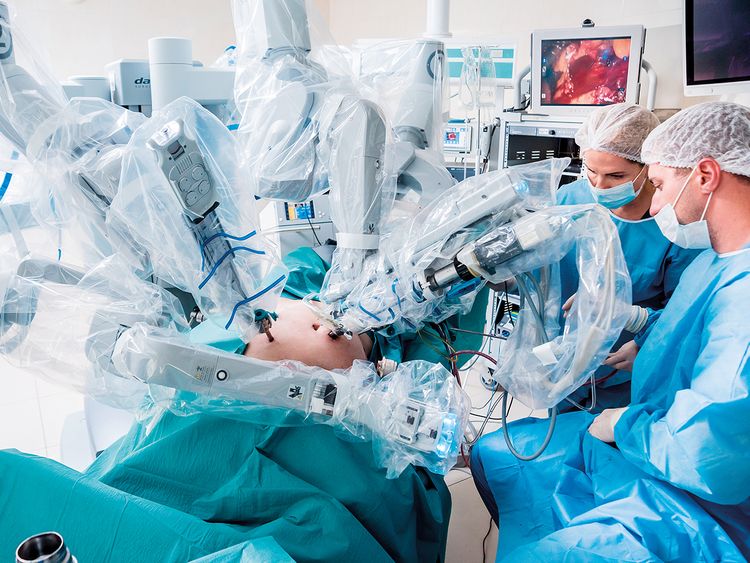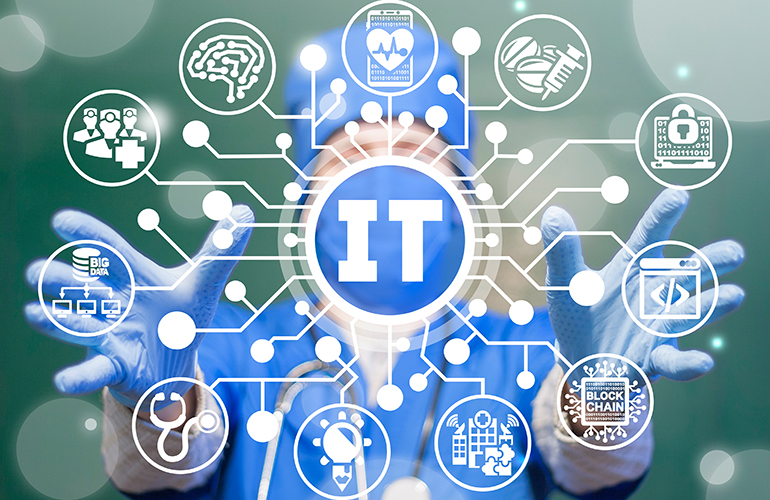COVID-19 has become an unprecedented disruption to all facets of the healthcare industry in a very short amount of time. Although the healthcare technology industry has been slow growing in the past, innovation is needed to deal with the pandemic. AI in healthcare, as well as other important technologies, are critical to resolving the crisis and for generating future growth.
To better understand where the healthcare technology industry is going, studying key tech trends is paramount. Although proven systems are often preferred for their reliability, businesses are always looking for new ways to improve their performance, productivity, and efficiency.
Now, let’s talk about healthcare technology trends in 2021.
Trend #1: Telemedicine
COVID-19 has greatly accelerated the use of telehealth resources. In April of 2020, 43.5% of Medicare primary care visits utilized telehealth methods rather than in-person visits. One of the major benefits of telehealth over in-person alternatives is that it reduces contact between patients, healthcare workers, and other patients. Wearable devices enable healthcare workers to have real-time information on patient data while they remain at home.
More importantly, telehealth’s growth appears likely to continue even after the pandemic is over. 71% of patients in the United States considered telemedicine at the beginning of the pandemic, and 50% had already utilized virtual appointments. With telehealth already rising in popularity in the previous year, the pandemic was a major boost to the industry’s development. This boom in telehealth seems likely to break $185.6 billion by 2026.
The most important aspect of telehealth’s success is patient adoption. Since most patients are comfortable with telehealth solutions, it’s clear that the industry has a strong future.
The most robust telehealth services are provided through telemedicine apps. One of the most important technologies behind telemedicine apps is WebRTC, an open-source API-based system to connect web browsers with mobile applications. One of the most important aspects of WebRTC that makes it essential for telemedicine apps is its versatility. This can enable useful features like text and video chat, screen sharing, and file transfer.
Electronic health records (EHR) are important to integrate into your telemedicine app. This allows patients and healthcare providers to see patient medical records in the app. Interactive Voice Response (IVR) is useful for the app to relay communication to patients through digital speech. Google fit and Apple HealthKit integration also presents valuable opportunities for allowing the app to access existing health information available on a patient’s own smartphone. Cloud-based server solutions are also critical for all of the above processes to function.
When building a telemedicine app, it’s important to consider what features it should have. Some of the most important features are security, location services, appointment management, video/audio communication, secure messaging, healthcare provider reviews, visit history, and wireless testing through wearable integration. From security to accessibility, these features are essential when considering the needs of a telemedicine app.

Trend #2: Artificial Intelligence Against COVID-19
Artificial intelligence plays a critical role in the fight against COVID-19, including areas like pandemic detection, vaccine development, thermal screening, facial recognition with masks, and analyzing CT scans.
PANDEMIC DETECTION
BlueDot, an application developed by a company from Toronto, Canada, was a major pioneer in early warning systems for identifying pandemics such as COVID-19. BlueDot was the first to publish a paper that predicted COVID-19’s spread worldwide.
Bluedot’s system scans over 100,000 media sources worldwide in over 65 different languages daily to ascertain dangerous outbreaks in nearly real time. To predict the risk of a disease becoming a pandemic, the following threat vectors are analyzed:
- Insect and animal populations
- Global and regional climate conditions
- Flight data and itineraries worldwide
- Capacity of health systems
- Vaccine Development
According to the Brookings Institution, when developing new vaccines, the goal is to include strongly immunogenic viral components that cause a response from the immune system. Machine learning has enabled great strides in immunology. Artificial intelligence can help identify viral fragments that have the properties needed to accomplish these goals.
Machine learning enables advancements that humans would not be able to achieve otherwise. The precision, efficiency, and speed of these developments cannot be achieved with human work alone. With machine assistance, immunologists have identified over one million fragments of proteins on a cell’s surface that are discoverable by T-cells.
SYGFQPTNGVGYQPY, a fragment from COVID-19, could be a fragment with these desirable qualities. However, without machine learning assistance, humans alone won’t be able to tell for sure. Thanks to machine learning, COVID-19 vaccine development is continuing quickly.
THERMAL SCREENING
According to the FDA, non-contact infrared thermometers and other kinds of thermal screening systems use a variety of methods to determine the temperature of objects like humans. AI can quickly parse through many people at once to identify people with high temperatures. This can help to identify symptomatic individuals.
FACIAL RECOGNITION WITH MASKS
Deep learning systems in facial recognition technology have improved enough that they can identify individuals with masks with accuracy of up to 95%. Even though large numbers of people are wearing masks, facial recognition is not concerned with whether or not they are wearing masks.
CT SCAN ANALYSIS
Human error is a problem in CT scan analysis. Artificial intelligence can detect pneumonia caused by COVID-19 in chest CT scans via multinational training data for machine learning.
Trend #3: The Internet of Medical Things (IoMT)
Various devices and mobile apps have come to play a critical role in tracking and preventing chronic illnesses for many patients and their doctors. By combining IoT development with telemedicine and telehealth technologies, a new Internet of Medical Things (IoMT) has emerged. This approach includes the use of a number of wearables, including ECG and EKG monitors. Many other common medical measurements can also be taken, such as skin temperature, glucose level, and blood pressure readings.
By 2025, the IoT industry will be worth $6.2 trillion. The healthcare industry has become so reliant on IoT technology in 2020 that 30% of that market share for IoT devices will come from healthcare.
With the arrival of new delivery methods, such as the first smart pill approved in 2017 by the FDA, practitioners will have many interesting options for providing care in a more effective manner.

Providing consistent and effective communication with numerous medical IoT devices is one of the biggest challenges that the sector faces. Manufacturers still regularly utilize their own proprietary protocols for talking to devices. This can present problems, especially when trying to collect large amounts of data by servers.
Connectivity issues are also still common, as the collection of data by microcontrollers and smartphones can be disrupted by a number of factors in the environment. Buffering methods on local microcontrollers need to become more robust in order to maintain better connections. Potential security concerns also need to be addressed, as indicated by a report from the Ponemon Institute’s Sixth Annual Benchmark Study on Privacy and Security of Healthcare Data that showed that 89% of healthcare operations had been the subjects of at least one data breach.

Trend #4: Privacy Issues
Privacy is an extremely important issue in health technology, especially with regards to HIPAA compliance in 2020. Although cloud computing can make storing and retrieving data more efficient, regulations to secure Protected Health Information (ePHI) are very strict and complying with them can be very difficult.
Remote communication with patients is especially important during the COVID-19 public health emergency. Some telehealth technologies are not fully compliant with HIPAA which can raise challenges for patient privacy. Although the Office for Civil Rights at the Department of Health and Human Services are currently exercising discretion on how these rules are enforced, it is still important for these technologies to be as compliant as possible.
The slack in enforcement of HIPAA rules is only in good faith. Healthcare providers should ensure that they are still following the regulations as best as they can, only missing the bar where they have to. For example, there are some non-public facing technologies in use by some providers to communicate with patients such as FaceTime and Skype.
If a healthcare provider wants to use an existing system to exchange ePHI with patients through third party software, they will have to obtain a business associate exception with the vendor which can be tedious and difficult. There still is no guarantee that the third party program can fully protect patient data.
In addition, keeping information secure through remote doctor calls is difficult. ePHI data must be transmitted in structured formats, and these calls can make the process complicated. Without compliance with HIPAA, patient privacy cannot be guaranteed. Beyond HIPAA, the General Data Protection Regulation must be considered in order to secure personal data from European Union citizens.


